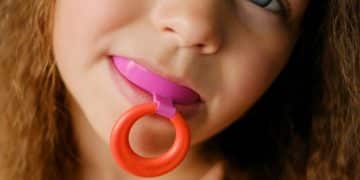Teething Troubles? 5 Doctor-Recommended Remedies for Pain Relief

Teething troubles can be a challenging phase for both babies and parents; doctor-recommended remedies such as chilled teething rings, gentle gum massage, and appropriate pain relievers can provide effective relief.
Teething troubles? 5 Doctor-Recommended Remedies for Pain Relief. The arrival of a baby’s first tooth can be an uncomfortable experience, but understanding how to alleviate your baby’s pain can make this milestone more manageable for both of you.
Understanding Teething and Its Symptoms
Teething is a natural developmental process where a baby’s teeth erupt through their gums. While it is a normal part of growth, it often comes with discomfort for the baby and concern for the parents.
What Age Does Teething Typically Start?
Teething usually begins around 6 months of age, but the timing can vary significantly among babies. Some infants may show signs of teething as early as 3 months, while others may not start until after their first birthday.
It’s important to remember that every child is different, and there’s a wide range of what’s considered normal in terms of when teething begins.
Common Symptoms of Teething
Understanding the signs of teething can help you provide timely comfort and relief. Here are some common symptoms to watch for:
- Increased Drooling: Excessive saliva production often accompanies teething, which can sometimes lead to a rash around the mouth.
- Gum Swelling and Tenderness: The gums may appear red, swollen, and sensitive to the touch. Babies might rub their gums or try to put objects in their mouth to chew on.
- Irritability: Teething pain can cause fussiness and crankiness. Your baby may seem more easily frustrated or upset.
- Sleep Disturbances: Teething discomfort can disrupt your baby’s sleep patterns, leading to more frequent wake-ups during the night.
- Loss of Appetite: Some babies experience a temporary decrease in appetite due to gum soreness making feeding uncomfortable.
Recognizing these symptoms early on can help you distinguish teething from other possible causes of discomfort and allow you to implement appropriate soothing measures.
In summary, being aware of the typical age range for teething and the various symptoms associated with it will allow you to better care for your baby during this phase.
Doctor-Recommended Remedies for Teething Pain
Consulting with pediatricians and dentists offers valuable insights into safe and effective methods for easing your baby’s pain during teething.
Chilled Teething Rings
One of the most frequently recommended solutions is the use of chilled teething rings. The coldness helps to numb the gums, providing temporary relief from pain and inflammation.
It is essential to use rings made from safe, non-toxic materials that are designed specifically for teething. Ensure that the rings are clean and free from any potential choking hazards.
Gentle Gum Massage
Massaging your baby’s gums with a clean finger or a soft, damp cloth can also alleviate discomfort. The pressure helps to counteract the pain by providing a counter-stimulus.
Gently rub the affected areas using small, circular motions. This can be particularly effective when combined with the application of gentle pressure.
Appropriate Pain Relievers
In some cases, over-the-counter pain relievers may be necessary to manage more severe teething pain. Always follow your pediatrician’s recommendations regarding appropriate medications and dosages.
- Acetaminophen (Tylenol): This is a common choice for relieving pain and reducing fever.
- Ibuprofen (Advil or Motrin): This can also help with pain and inflammation. Make sure your baby is at least 6 months old before using ibuprofen.
It is crucial to avoid using products containing benzocaine, as they can be harmful to young children. Always read labels carefully and consult with your healthcare provider before administering any medication.

In short, a combination of chilled teething rings, gentle gum massage, and, when necessary, appropriate pain relievers can offer effective relief for your teething baby.
Safe and Effective Teething Toys
Teething toys are designed to provide babies with something safe to chew on, helping to relieve gum pressure and discomfort.
Choosing the Right Teething Toy
When selecting teething toys, it’s important to look for options that are made from safe, non-toxic materials. Avoid toys with small parts that could pose a choking hazard.
Opt for toys that are easy to clean and maintain. Regularly wash teething toys to prevent the buildup of harmful bacteria.
Types of Teething Toys
There are various types of teething toys available, each offering different textures and features to soothe your baby’s gums.
- Silicone Teethers: These are soft, flexible, and gentle on the gums. They often come in different shapes and textures to provide varied sensory stimulation.
- Wooden Teethers: Natural and free from harmful chemicals, wooden teethers are a popular choice for eco-conscious parents.
- Water-Filled Teethers: These can be chilled in the refrigerator to provide a cooling sensation, which can help to numb the gums.
- Textured Teethers: These come with bumps, ridges, and other textured surfaces that provide additional gum massage and relief.
Experiment with different types to see which ones your baby prefers. A variety of textures can help keep your baby engaged and provide targeted relief to different areas of the gums.
To summarize, choosing safe, non-toxic, and varied teething toys can provide effective relief for your baby’s teething discomfort.
The Role of Diet During Teething
Adjustments to your baby’s diet can also play a role in managing teething discomfort. Certain foods and feeding methods may provide additional relief.
Soothing Foods for Teething Babies
Offering cool, soft foods can help to soothe inflamed gums. Cold purees, yogurt, or applesauce can be both nourishing and comforting for your baby.
Avoid giving your baby sugary or acidic foods, as these can irritate the gums and increase the risk of tooth decay once the teeth erupt.
Feeding Techniques for Teething
Consider offering smaller, more frequent meals if your baby is experiencing a loss of appetite due to teething. This can help ensure they still receive adequate nutrition.
If your baby is bottle-fed, use a soft nipple and hold them in a comfortable position. Avoid forcing them to feed if they are showing signs of pain or discomfort.

In summary, providing cool, soft foods and adjusting feeding techniques can help ease your baby’s discomfort and maintain their nutritional intake during teething.
When to Consult a Doctor
While teething is a normal process, it’s important to know when certain symptoms may indicate a more serious issue that requires medical attention.
Distinguishing Teething Symptoms from Illness
Teething itself does not cause fever, diarrhea, or a runny nose. If your baby develops these symptoms, it’s more likely due to an underlying illness.
Consult your pediatrician if your baby has a high fever (over 100.4°F or 38°C), persistent diarrhea, vomiting, or a severe rash. These signs may indicate an infection or other medical condition.
Seeking Professional Advice
If you are unsure whether your baby’s symptoms are related to teething or something else, it’s always best to seek professional advice. Your pediatrician can help rule out other potential causes and provide appropriate treatment recommendations.
- Fever and Symptoms: If teething is accompanied by a fever or other symptoms, consult a doctor to rule out other problems.
- Prolonged Irritability: Constant screaming and crying when teething can cause high-stress levels in the baby.
Be prepared to describe your baby’s symptoms in detail, so your doctor can make an informed diagnosis. Early intervention can help prevent complications and ensure your baby receives the care they need.
Ultimately, knowing when to differentiate teething pains with serious medical conditions ensures that your baby achieves the care and attention he requires.
Preventative Measures and Oral Hygiene
Establishing good oral hygiene habits early on is essential for your baby’s dental health. Even before the first tooth erupts, you can take steps to care for their gums.
Cleaning Your Baby’s Gums
After each feeding, gently wipe your baby’s gums with a soft, damp cloth or a gauze pad. This helps remove bacteria and food particles.
This practice also gets your baby accustomed to having their mouth and gums cleaned, which can make the transition to toothbrushing easier later on.
Introducing Toothbrushing
Once the first tooth appears, start brushing it gently with a soft-bristled toothbrush. Use a small amount of fluoride toothpaste (about the size of a grain of rice).
- Brush Gently and Regularly: Use a toothbrush, and gently brush the teeth twice per day.
- Avoid Sugary Substances: Prolonged exposure to sugary substances can cause the baby to develop early tooth decay.
Make toothbrushing a positive and enjoyable experience for your baby. Sing songs or use playful techniques to make it fun. Regular oral care and preventative measures prevent dental problems.
Overall, taking preventative measures and making oral hygiene a routine from the start is a very safe, efficient, and effective means of protecting babies’ dental health.
| Key Point | Brief Description |
|---|---|
| 🧊 Chilled Teething Rings | Numbs gums to relieve pain and inflammation. |
| 🖐️ Gentle Gum Massage | Counteracts pain with gentle circular motions. |
| 💊 Pain Relievers | Acetaminophen or Ibuprofen as per doctor’s advice. |
| 🍎 Soothing Foods | Cold purees and yogurts for gum relief. |
Frequently Asked Questions (FAQ)
▼
The first signs of teething may include increased drooling, irritability, gum swelling, and the urge to chew on objects. These symptoms typically begin around 6 months of age, but can vary.
▼
Teething itself does not cause a high fever. If your baby has a fever over 100.4°F (38°C), consult a doctor, as it is more likely due to an illness unrelated to teething.
▼
You can gently wipe your baby’s gums with a soft, damp cloth or gauze pad after each feeding. This helps remove bacteria and food particles, promoting good oral hygiene.
▼
Once the first tooth appears, you can start brushing it gently with a soft-bristled toothbrush and a smear of fluoride toothpaste (about the size of a grain of rice).
▼
Teething necklaces are not recommended due to the risk of choking and strangulation. It’s best to stick to safer options like teething rings and gum massage for relieving teething pain.
Conclusion
Managing teething discomfort involves a combination of gentle care, safe remedies, and good oral hygiene practices. By understanding the symptoms and implementing doctor-recommended strategies, you can help your baby through this developmental phase with greater ease and comfort.





